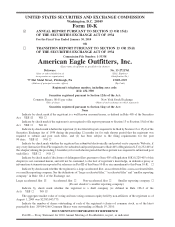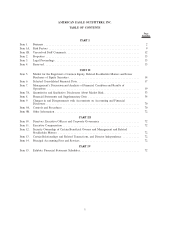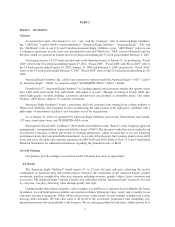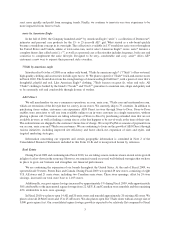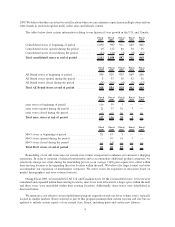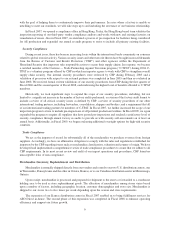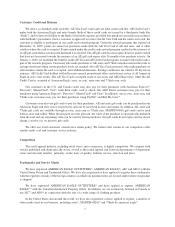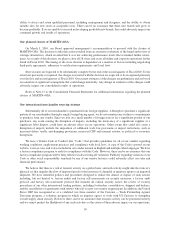American Eagle Outfitters 2009 Annual Report Download - page 7
Download and view the complete annual report
Please find page 7 of the 2009 American Eagle Outfitters annual report below. You can navigate through the pages in the report by either clicking on the pages listed below, or by using the keyword search tool below to find specific information within the annual report.with the goal of helping them to continuously improve their performance. In cases where a factory is unable or
unwilling to meet our standards, we will take steps up to and including the severance of our business relationship.
In Fiscal 2007, we opened a compliance office in Hong Kong. Today, the Hong Kong-based team validates the
inspection reporting of our third-party vendor compliance auditors and works with new and existing factories on
remediation of issues. Also in Fiscal 2007, we instituted a process of pre-inspection for facilities being considered
for AE production and expanded our annual re-audit program to strive to include all primary existing facilities.
Security Compliance
During recent years, there has been an increasing focus within the international trade community on concerns
related to global terrorist activity. Various security issues and other terrorist threats have brought increased demands
from the Bureau of Customs and Border Protection (“CBP”) and other agencies within the Department of
Homeland Security that importers take responsible action to secure their supply chains. In response, we became
a certified member of the Customs — Trade Partnership Against Terrorism program (“C-TPAT”) during 2004. C-
TPAT is a voluntary program offered by CBP in which an importer agrees to work with CBP to strengthen overall
supply chain security. Our internal security procedures were reviewed by CBP during February 2005 and a
validation of processes with respect to our external partners was completed in June 2005 and then re-evaluated in
June 2008. We received formal written validations of our security procedures from CBP during the first quarter of
Fiscal 2006 and the second quarter of Fiscal 2008, each indicating the highest level of benefits afforded to C-TPAT
members.
Historically, we took significant steps to expand the scope of our security procedures, including, but not
limited to: a significant increase in the number of factory audits performed; a revision of the factory audit format to
include a review of all critical security issues as defined by CBP; a review of security procedures of our other
international trading partners, including forwarders, consolidators, shippers and brokers; and a requirement that all
of our international trading partners be members of C-TPAT. In Fiscal 2007, we further increased the scope of our
inspection program to strive to include pre-inspections of all potential production facilities. In Fiscal 2009, we again
expanded the program to require all suppliers that have passed pre-inspections and reached a satisfactory level of
security compliance through annual factory re-audits to provide us with security self-assessments on at least an
annual basis. Additionally, in Fiscal 2009, we began evaluating additional oversight options for high-risk security
countries.
Trade Compliance
We act as the importer of record for substantially all of the merchandise we purchase overseas from foreign
suppliers. Accordingly, we have an affirmative obligation to comply with the rules and regulations established for
importers by the CBP regarding issues such as merchandise classification, valuation and country of origin. We have
developed and implemented a comprehensive series of trade compliance procedures to assure that we adhere to all
CBP requirements. In its most recent review and audit of our import operations and procedures, CBP found no
unacceptable risks of non-compliance.
Merchandise Inventory, Replenishment and Distribution
Merchandise is normally shipped directly from our vendors and routed to our two U.S. distribution centers, one
in Warrendale, Pennsylvania and the other in Ottawa, Kansas, or to our Canadian distribution center in Mississauga,
Ontario.
Upon receipt, merchandise is processed and prepared for shipment to the stores or forwarded to a warehouse
holding area to be used as store replenishment goods. The allocation of merchandise among stores varies based
upon a number of factors, including geographic location, customer demographics and store size. Merchandise is
shipped to our stores two to five times per week depending upon the season and store requirements.
The expansion of our Kansas distribution center in Fiscal 2007 enabled us to bring fulfillment services for
AEO Direct in-house. The second phase of this expansion was completed in Fiscal 2008 to enhance operating
efficiency and support our future growth.
6

